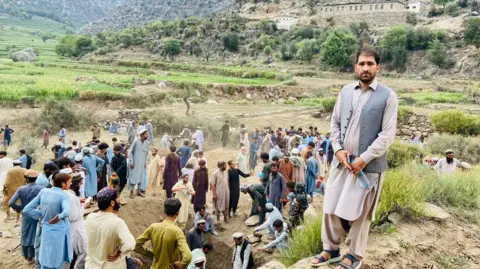In the heart-wrenching aftermath of recent wildfires that swept through Los Angeles, communities faced overwhelming losses, with thousands of homes reduced to ash and at least ten lives tragically cut short. As the flames relented, residents returned to their devastated neighborhoods, hoping to salvage pieces of their former lives and find solace in the small relics of daily existence.
In Altadena, one of the hardest-hit areas, families resiliently dug through the debris to uncover mementos that, although insignificant in the grand scheme, spark joy amid sorrow. Young Henry Giles stood among the charred remains of his home, elated to discover a toy lawn mower he had cleverly hidden in the bushes before evacuation. "Mommy look, they survived!" he shouted, embodying the innocence and optimism of youth amidst uncertainty.
Nearby, Deisy Suarez unearthed a page from her favorite self-help book, clinging to it as a "divine message" that encouraged her to persevere. "I read a lot of books on self-growth and empowerment," she shared, adding to the emotional weight of sifting through her smoldering dream home.
Larry Villescas, searching through the wreckage alongside his family, found remnants of wedding gifts, including a cherished bowl and plate from his great aunt that survived the fierce blaze. "Everything is basically gone, but the small things you do find become even more special," he remarked, highlighting the deep emotional connections survivors hold to their belongings.
Among the rubble, a shattered vase captured the memory of Daron Anderson's mother, a lasting connection that transcended the destruction. "If we find something that's intact, I can take it back to my mom," he said, reflecting on the personal and historical significance tied to these artifacts.
Peter Mitchell offered a poignant perspective on loss, having built many of the destroyed features in his home. "Material things can be replaced," he said, surveying his old tools, "but it's the memories that matter." His neighbor, Tavia Weinmann, found two pearls from her mother's necklace buried beneath the debris—a treasure borne of heartbreak.
As these families confront the grim reality of their situation, they confront loss not only through tangible items but through the emotional wounds that will take much longer to heal. Yet within their sorrow emerges an undeniable strength—a steadfast commitment to rebuild their lives, piece by piece. The recovery will be arduous, but as they cling to the remnants of their past, these survivors embody an enduring spirit determined to forge a brighter, more hopeful future.





















